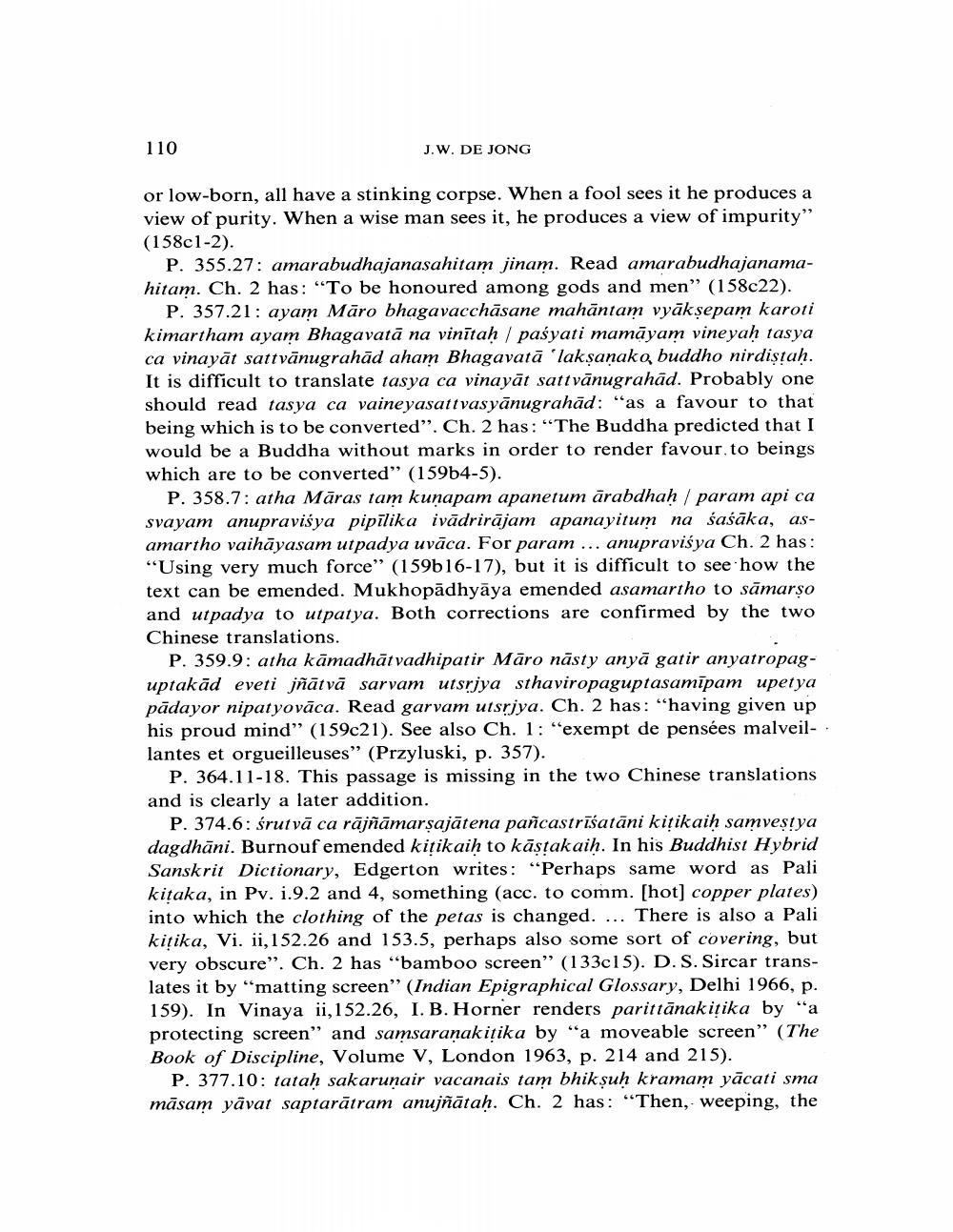Book Title: Notes On Text Of Asoka Legend Author(s): J W De Jong Publisher: J W De Jong View full book textPage 8
________________ 110 J. W. DE JONG or low-born, all have a stinking corpse. When a fool sees it he produces a view of purity. When a wise man sees it, he produces a view of impurity" (158c1-2). P. 355.27: amarabudhajanasahitam jinam. Read amarabudhajanamahitam. Ch. 2 has: "To be honoured among gods and men" (158c22). P. 357.21: ayam Märo bhagavacchasane mahāntam vyākṣepam karoti kimartham ayam Bhagavata na vinitaḥ pakyati mamāyam vineyaḥ tasya ca vinayat sattvänugrahad aham Bhagavata 'lakṣaṇako, buddho nirdistah. It is difficult to translate tasya ca vinayāt sattvānugrahād. Probably one should read tasya ca vaineyasattvasyänugrahād: "as a favour to that being which is to be converted". Ch. 2 has: "The Buddha predicted that I would be a Buddha without marks in order to render favour to beings which are to be converted" (159b4-5). P. 358.7: atha Māras tam kunapam apanetum arabdhaḥ param api ca svayam anupravisya pipilika ivädrirājam apanayitum na šašāka, asamartho vaihāyasam utpadya uvāca. For param... anupraviśya Ch. 2 has: "Using very much force" (159b16-17), but it is difficult to see how the text can be emended. Mukhopadhyaya emended asamartho to samarṣo and utpadya to utpatya. Both corrections are confirmed by the two Chinese translations. P. 359.9: atha kamadhātvadhipatir Māro nāsty anyā gatir anyatropaguptakad eveti jäätvä sarvam utsrjya sthaviropaguptasamipam upetya padayor nipatyovaca. Read garvam utsriya. Ch. 2 has: "having given up his proud mind" (159c21). See also Ch. 1: "exempt de pensées malveil-. lantes et orgueilleuses" (Przyluski, p. 357). P. 364.11-18. This passage is missing in the two Chinese translations and is clearly a later addition. P. 374.6: śrutvā ca rājñāmarṣajātena pañcastrisatāni kitikaiḥ samvestya dagdhani. Burnouf emended kitikaiḥ to kāṣṭakaiḥ. In his Buddhist Hybrid Sanskrit Dictionary, Edgerton writes: "Perhaps same word as Pali kiṭaka, in Pv. i.9.2 and 4, something (acc. to comm. [hot] copper plates) into which the clothing of the petas is changed. ... There is also a Pali kitika, Vi. ii, 152.26 and 153.5, perhaps also some sort of covering, but very obscure". Ch. 2 has "bamboo screen" (133c15). D. S. Sircar translates it by "matting screen" (Indian Epigraphical Glossary, Delhi 1966, p. 159). In Vinaya ii,152.26, I. B. Horner renders parittänakitika by "a protecting screen" and samsaranakitika by "a moveable screen" (The Book of Discipline, Volume V, London 1963, p. 214 and 215). P. 377.10: tataḥ sakaruṇair vacanais tam bhik şuḥ kramam yacati sma masam yavat saptarätram anujñātah. Ch. 2 has: "Then, weeping, thePage Navigation
1 ... 6 7 8 9 10 11
